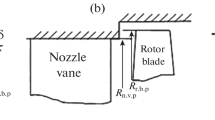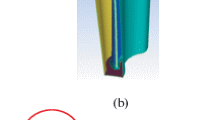Abstract
The last stages of powerful power gas turbines play an important role in the development of power and efficiency of the whole unit as well as in the distribution of the flow parameters behind the last stage, which determines the efficient operation of the exhaust diffusers. Therefore, much attention is paid to improving the efficiency of the last stages of gas turbines as well as the distribution of flow parameters. Since the long blades of the last stages of multistage high-power gas turbines could fall into the resonance frequency range in the course of operation, which results in the destruction of the blades, damping wires or damping bolts are used for turning out of resonance frequencies. However, these damping elements cause additional energy losses leading to a reduction in the efficiency of the stage. To minimize these losses, dampening shrouds are used instead of wires and bolts at the periphery of the working blades. However, because of the strength problems, designers have to use, instead of the most efficient full shrouds, partial shrouds that do not provide for significantly reducing the losses in the tip clearance between the blade and the turbine housing. In this paper, a computational study is performed concerning an effect that the design of the shroud of the turbine-working blade exerted on the flow structure in the vicinity of the shroud and on the efficiency of the stage as a whole. The analysis of the flow structure has shown that a significant part of the losses under using the shrouds is associated with the formation of vortex zones in the cavities on the turbine housing before the shrouds, between the ribs of the shrouds, and in the cavities at the outlet behind the shrouds. All the investigated variants of a partial shrouding are inferior in efficiency to the stages with shrouds that completely cover the tip section of the working blade. The stage with a unshrouded working blade was most efficient at the values of the relative tip clearance less than 0.9%.
Similar content being viewed by others
References
V. Vassiliev, S. Irmisch, S. Abdel-Wahab, and A. Granovskiy, “Impact of the inflow conditions on the heavy-duty gas turbine exhaust diffuser performance,” J. Turbomach. 134, 041018 (2012).
K. M. Popov, M. Kh. Mukhtarov, L. I. Kiselev, and I. V. Safron’ev, “The effect of radial clearance and working blade shrouding on efficiency losses of highloaded cooled turbines,” Tr. Tsentr. Inst. Aviats. Mashinstr., No. 911 (1980).
A. M. Wallis, J. D. Denton, and A. A. J. Demargne, “The control of shroud leakage flows to reduce aerodynamic losses in a low aspect ratio, shrouded axial flow turbine,” ASME Paper No. 2000-GT-475 (Am. Soc. Mech. Eng., 2000).
L. Porreca, T. Behr, J. Schlienger, A. I. Kalfas, R. S. Abhari, J. Ehrhard, and E. Janke, “Fluid dynamics and performance of partially and fully shrouded axial turbines,” J. Turbomach. 127, 668–678 (2005).
K. Wolter, A. Giboni, P. Peters, J. R. Menter, and H. Pfost, “Experimental and numerical investigation of the unsteady leakage flow through the rotor tip labyrinth of a 1.5-stage axial turbine,” ASME Paper No. GT2005-68156 (Am. Soc. Mech. Eng., 2005).
P. Adami, A. Milli, F. Martelli, and S. Cecchi, “Comparison of different shroud configurations in high-pressure turbines using unsteady CFD,” ASME Paper No. GT2006-90442 (Am. Soc. Mech. Eng., 2006).
B. Rosic and J. D. Denton, “Control of shroud leakage loss by reducing circumferential mixing,” J. Turbomach. 130, 021010 (2008).
I. Mahle and R. Schmierer, “Inverse fin arrangement in a low pressure turbine to improve the interaction between shroud leakage flows and main flow,” ASME Paper No. GT2011-45250 (Am. Soc. Mech. Eng., 2011).
S. Yoon, E. Curtis, J. Denton, and J. Longley, “The effect of clearance on shrouded and unshrouded turbines at two levels of reaction,” J. Turbomach. 136, 021013 (2014).
S. Le Guyader, J. De'molis, and J. Munoz, “Effects of tip shroud geometries on low-pressure turbine performance,” ASME Paper No. GT2016-56006 (Am. Soc. Mech. Eng., 2016).
V. G. Gribin, S. S. Dmitriev, B. N. Petrunin, and A. A. Gusev, “Rectangular-cellular seals for steam turbines,” Izv. Vyssh. Uchebn. Zaved. Mashinostr., No. 3, 22–30 (2017).
Author information
Authors and Affiliations
Corresponding author
Additional information
Original Russian Text © I.V. Afanas’ev, A.V. Granovskii, 2018, published in Teploenergetika.
Rights and permissions
About this article
Cite this article
Afanas’ev, I.V., Granovskii, A.V. Computational Study on the Effect of Shroud Shape on the Efficiency of the Gas Turbine Stage. Therm. Eng. 65, 136–142 (2018). https://doi.org/10.1134/S0040601518030011
Received:
Accepted:
Published:
Issue Date:
DOI: https://doi.org/10.1134/S0040601518030011




